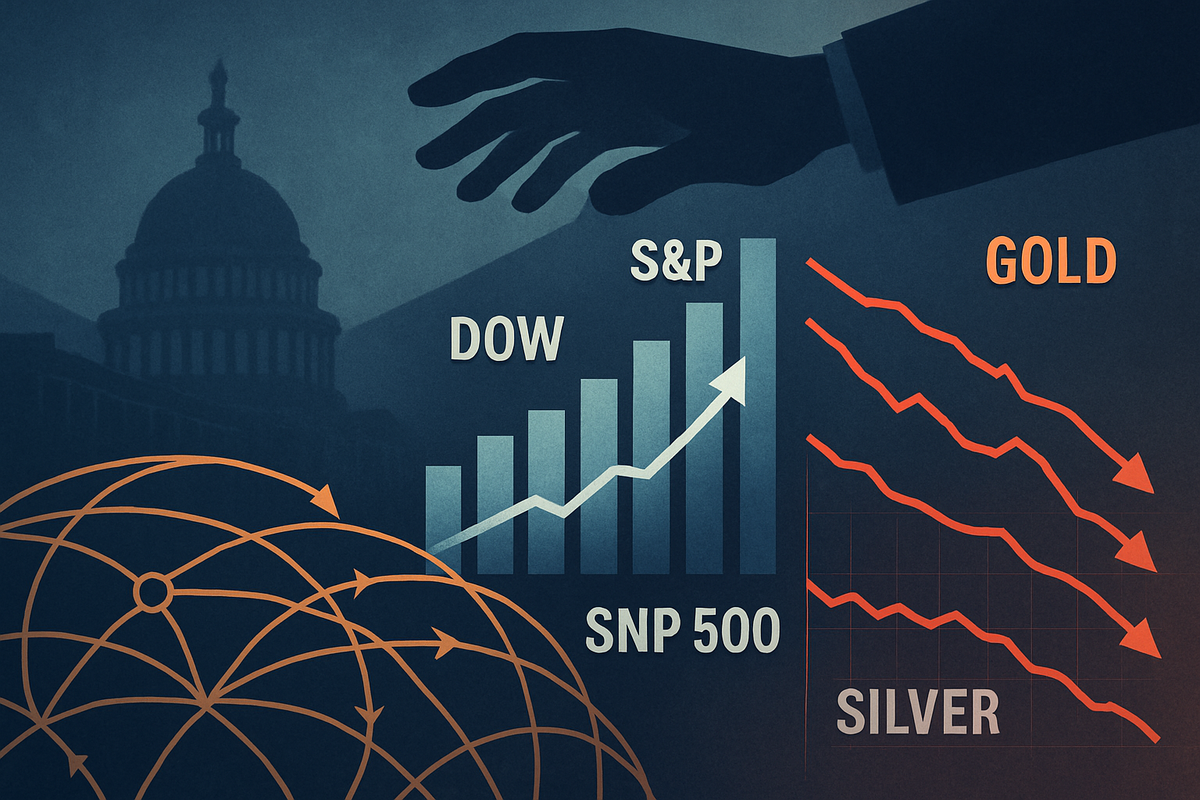
Washington D.C. – October 17, 2025 – Global financial markets breathed a collective sigh of relief today as former President Donald Trump's latest comments regarding proposed tariffs on China offered a glimmer of de-escalation, prompting a modest rebound in key U.S. stock indices. The Dow Jones Industrial Average (NYSE: ^DJI), S&P 500 (NYSE: ^GSPC), and Nasdaq Composite (NASDAQ: ^IXIC) advanced or pared earlier losses, signaling investor optimism that a full-blown trade war might be averted, or at least postponed. Conversely, safe-haven assets that had soared to record highs on previous trade war fears, such as gold and silver, experienced a notable pullback.
The market's reaction underscores the profound influence of geopolitical rhetoric on investor sentiment, particularly concerning the contentious trade relationship between the United States and China. Coming after weeks of escalating threats and counter-threats, Trump's more conciliatory tone provided a much-needed respite, allowing equities to recover some ground while precious metals adjusted to the shifting landscape of perceived risk.
De-escalation Rhetoric Provides Temporary Market Calm
The catalyst for today's market movements stemmed from Donald Trump's interview with Fox Business Network, aired on Friday, October 17, 2025, though taped the previous day. In a pivotal moment, Trump suggested that his proposed 100% tariffs on Chinese goods would "not be sustainable," while simultaneously confirming an upcoming meeting with Chinese President Xi Jinping in South Korea. These remarks marked a noticeable softening from his earlier, more aggressive stance, which had threatened sweeping levies and new export controls by November 1st in response to China's restrictions on rare earth element exports.
The timeline leading to this moment has been a rollercoaster for markets. Just a week prior, on Friday, October 10, 2025, Trump's threats of a 100% tariff on Chinese imports sent shockwaves, causing the S&P 500 to sink 2.7%, its worst day since April, and the Dow to drop 878 points. However, a slight reprieve came on Monday, October 13, 2025, when Trump posted on Truth Social, stating, "Don't worry about China, it will all be fine!" This brief moment of softened rhetoric saw the Dow rise over 500 points, the S&P 500 gain 1.24%, and the Nasdaq climb 1.54%. Today's comments further built on that easing, preventing a more significant market downturn.
On Friday, October 17, 2025, the immediate market reactions were palpable. The Dow Jones Industrial Average (NYSE: ^DJI) advanced 0.2% in recent trading, having initially risen by 21 points at the open. The S&P 500 (NYSE: ^GSPC) was near flat, paring earlier declines, while the Nasdaq Composite (NASDAQ: ^IXIC) though still down 0.1%, also recovered from steeper early losses. In stark contrast, gold prices, which had hit a new record high of $4,392 per ounce early in the day, pulled back 1% to $4,250 and were reported down 2% at $4,234 per ounce. Silver prices mirrored this trend, retreating from a record high of $54.86 per ounce reached in the previous session, falling to around $53.65 per ounce (down 1.20% on the day). Key players in this ongoing saga include former President Donald Trump, Chinese President Xi Jinping, and the global investment community grappling with the implications of their pronouncements.
Companies Navigate the Trade Winds: Potential Winners and Losers
The fluctuating rhetoric surrounding U.S.-China trade relations creates a volatile landscape for public companies, with potential winners and losers emerging depending on their exposure and adaptability. Companies with extensive supply chains deeply integrated with China, particularly in sectors like technology, automotive, and consumer goods, are highly sensitive to tariff threats. For these companies, any easing of trade tensions, as seen with Trump's latest comments, can be a significant positive. For example, major tech firms (NASDAQ: AAPL), which rely on Chinese manufacturing, might see reduced input costs or avoid increased consumer prices, potentially boosting their profit margins and sales. Similarly, multinational retailers (NYSE: WMT) importing goods from China could breathe easier, as the threat of tariffs directly impacts their cost of goods sold and, by extension, consumer prices.
Conversely, companies that had positioned themselves to benefit from a prolonged trade war, such as those in domestic manufacturing or those involved in reshoring initiatives, might see their competitive edge slightly diminished if tariffs are indeed scaled back. Furthermore, safe-haven assets like gold miners (NYSE: NEM) and silver producers (NYSE: FSM), which saw their valuations surge amidst geopolitical uncertainty, experienced a downturn as risk appetite returned to the broader market. While not direct "losers" in the traditional sense, their growth trajectory could slow if the perceived need for safe-haven investments diminishes.
The agricultural sector, particularly U.S. soybean and pork producers, also remains highly sensitive. Previous threats by Trump to "terminate business" with China over soybeans had sent jitters through this industry. Any sustained de-escalation could reopen critical export markets, benefiting companies like Archer-Daniels-Midland (NYSE: ADM) or Bunge Limited (NYSE: BG). However, the long-term impact on supply chain restructuring, with some companies already diversifying away from China, means that even a truce might not fully reverse some of the strategic shifts already in motion.
Wider Significance and Historical Context
The recent market reactions to Donald Trump's tariff comments highlight a broader industry trend: the increasing politicization of global trade and the resulting volatility in financial markets. This event fits into a pattern observed during Trump's previous presidency, where tweets and public statements frequently moved markets more dramatically than traditional economic indicators. The "new normal" for businesses involves navigating an environment where geopolitical risks are paramount, forcing companies to reconsider their global supply chains and market dependencies.
The ripple effects extend far beyond the immediate U.S.-China trade relationship. Partners and competitors across the globe, from European luxury brands (EPA: RMS) to Asian electronics manufacturers (KRX: 005930), are impacted by shifts in U.S. trade policy. Increased tariffs could lead to higher input costs, reduced consumer demand, and a general slowdown in global trade, affecting economies reliant on exports. Regulatory and policy implications are significant, as these comments shape expectations for future trade agreements, intellectual property protections, and the overall framework of international commerce. The upcoming meeting between Trump and Xi Jinping in South Korea will be closely watched as a potential turning point.
Historically, periods of heightened trade tensions have often led to market uncertainty and a flight to safety. Comparisons can be drawn to the U.S.-China trade war of 2018-2019, where tariffs on billions of dollars worth of goods led to significant market fluctuations, supply chain disruptions, and calls for diversification. However, the current situation is complicated by other factors, including ongoing global inflation, central bank policies, and regional conflicts, making the market's response even more nuanced. The exemption of gold bars from tariffs for allied countries in September 2025 also indicates a selective approach to trade policy, adding another layer of complexity.
What Comes Next: Navigating Continued Uncertainty
Looking ahead, the short-term focus will undoubtedly be on the confirmed meeting between Donald Trump and Chinese President Xi Jinping in South Korea. The outcome of this high-stakes encounter, whether it results in a concrete path to de-escalation or merely a continuation of dialogue, will largely dictate market sentiment in the immediate future. Any further softening of Trump's stance could lead to sustained gains in equities and a continued retreat for precious metals, while a re-escalation of threats could reverse these trends swiftly. Investors should prepare for continued volatility, as political rhetoric can shift rapidly.
In the long term, the landscape remains fraught with uncertainty. The potential for a renewed U.S. presidential election involving Donald Trump means that trade policy could remain a central and unpredictable factor in global markets for years to come. Companies may need to implement strategic pivots, focusing on diversifying their manufacturing bases, securing alternative supply routes, and hedging against currency fluctuations. Market opportunities may emerge in sectors that can demonstrate resilience to trade shocks, such as domestic infrastructure or companies offering supply chain resilience solutions. Conversely, challenges will persist for businesses heavily reliant on single-country supply chains or export markets.
Potential scenarios range from a negotiated truce, leading to a period of relative calm and economic growth, to a full-blown trade war, which could trigger a global economic slowdown. A middle-ground scenario involves continued "managed tension," where rhetoric flares periodically but stops short of catastrophic escalation. Investors should closely monitor not only official statements but also underlying economic data and geopolitical developments, as these will provide crucial signals for adapting their portfolios.
Comprehensive Wrap-Up: A Market on Edge
Today's market movements, driven by Donald Trump's latest tariff comments, serve as a potent reminder of how deeply intertwined politics and economics have become in the 21st century. The immediate relief felt by stock markets and the subsequent pullback in gold and silver underscore a key takeaway: investor confidence remains highly susceptible to shifts in trade rhetoric. While equities enjoyed a modest lift, and safe-haven assets cooled from their record highs, the underlying tensions in U.S.-China relations are far from resolved.
Moving forward, the market will likely remain on edge, reacting swiftly to any new pronouncements from key political figures or developments in international trade negotiations. The assessment of the market moving forward is one of cautious optimism, tempered by an awareness of inherent fragility. The confirmed meeting between Trump and Xi Jinping offers a potential pathway to de-escalation, but the history of their interactions suggests that unpredictability is the only constant.
The lasting impact of this period of trade uncertainty could include a permanent shift in global supply chains, increased emphasis on domestic production, and a re-evaluation of international trade agreements. What investors should watch for in the coming months includes the outcome of the U.S.-China meeting, any subsequent policy changes or executive orders regarding tariffs, and the broader geopolitical climate. The interplay between these factors will ultimately determine the direction of major indices and the trajectory of commodity prices.
This content is intended for informational purposes only and is not financial advice





